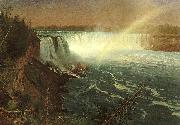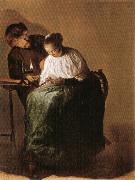
Oil On
Canvas, Real Flavor of Old Masters
|
Albert Bierstadt
|
|||
|
|
|||
| German-born American Hudson River School Painter, 1830-1902 Bierstadt was born in Solingen, Germany. His family moved to New Bedford, Massachusetts, in 1833. He studied painting with the members of the D??sseldorf School in D??sseldorf, Germany from 1853 to 1857. He taught drawing and painting briefly before devoting himself to painting. Bierstadt began making paintings in New England and upstate New York. In 1859, he traveled westward in the company of a Land Surveyor for the U.S. government, returning with sketches that would result in numerous finished paintings. In 1863 he returned west again, in the company of the author Fitz Hugh Ludlow, whose wife he would later marry. He continued to visit the American West throughout his career. Though his paintings sold for princely sums, Bierstadt was not held in particularly high esteem by critics of his day. His use of uncommonly large canvases was thought to be an egotistical indulgence, as his paintings would invariably dwarf those of his contemporaries when they were displayed together. The romanticism evident in his choices of subject and in his use of light was felt to be excessive by contemporary critics. His paintings emphasized atmospheric elements like fog, clouds and mist to accentuate and complement the feel of his work. Bierstadt sometimes changed details of the landscape to inspire awe. The colors he used are also not always true. He painted what he believed is the way things should be: water is ultramarine, vegetation is lush and green, etc. The shift from foreground to background was very dramatic and there was almost no middle distance Nonetheless, his paintings remain popular. He was a prolific artist, having completed over 500 (possibly as many as 4000) paintings during his lifetime, most of which have survived. Many are scattered through museums around the United States. Prints are available commercially for many. Original paintings themselves do occasionally come up for sale, at ever increasing prices. | |||
|
|
|||
|
|
Niagara Albert Bierstadt3.jpg Painting ID:: 2459 Visit European Gallery |
1869 19.02 x 27.01 ins / 48.3 x 68.6 cm Private collection | |
Height Width |
INS/CM |
||
|
X |
|
||
|
|
|||
|
Currier and Ives
|
|||
|
|
|||
| American Publisher, 1834-1907 | |||
|
|
|||
|
|
Niagara new4/Currier and Ives-237739.jpg Painting ID:: 30934 Visit European Gallery |
mk68 1857 | |
Height Width |
INS/CM |
||
|
X |
|
||
|
|
|||
|
Frederick Edwin Church
|
|||
|
|
|||
| 1826-1900 Frederick Edwin Church Galleries Frederic Edwin Church (May 4, 1826 ?C April 7, 1900) was an American landscape painter born in Hartford, Connecticut. He was a central figure in the Hudson River School of American landscape painters. While committed to the natural sciences, he was "always concerned with including a spiritual dimension in his works". The family wealth came from Church's father, Joseph Church, a silversmith and watchmaker in Hartford, Connecticut.(Joseph subsequently also became an official and a director of The Aetna Life Insurance Company) Joseph, in turn, was the son of Samuel Church, who founded the first paper mill in Lee, Massachusetts in the Berkshires, and this allowed him(Frederic) to pursue his interest in art from a very early age. At eighteen years of age, Church became the pupil of Thomas Cole in Catskill, New York after Daniel Wadsworth, a family neighbor and founder of the Wadsworth Atheneum, introduced the two. In May 1848, Church was elected as the youngest Associate of the National Academy of Design and was promoted to Academician the following year. Soon after, he sold his first major work to Hartford's Wadsworth Atheneum. Church settled in New York where he taught his first pupil, William James Stillman. From the spring to autumn each year Church would travel, often by foot, sketching. He returned each winter to paint and to sell his work. Between 1853 and 1857, Church traveled in South America, financed by businessman Cyrus West Field, who wished to use Church's paintings to lure investors to his South American ventures. Church was inspired by the Prussian explorer Alexander von Humboldt's Cosmos and his exploration of the continent; Humboldt had challenged artists to portray the "physiognomy" of the Andes. | |||
|
|
|||
|
|
Niagara new4/Frederick Edwin Church-584558.jpg Painting ID:: 31889 Visit European Gallery |
mk77 1857 Oil on canvas 42 1/4x990 1/2in | |
Height Width |
INS/CM |
||
|
X |
|
||
|
|
|||
|
Louis Remy Mignot
|
|||
|
|
|||
| Feb.3.1831-Sep.22.1870 | |||
|
|
|||
|
|
Niagara new12/Louis Remy Mignot-235525.jpg Painting ID:: 39076 Visit European Gallery |
mk140 1866 Oil on canvas 123.8x232.4cm | |
Height Width |
INS/CM |
||
|
X |
|
||
|
|
|||










